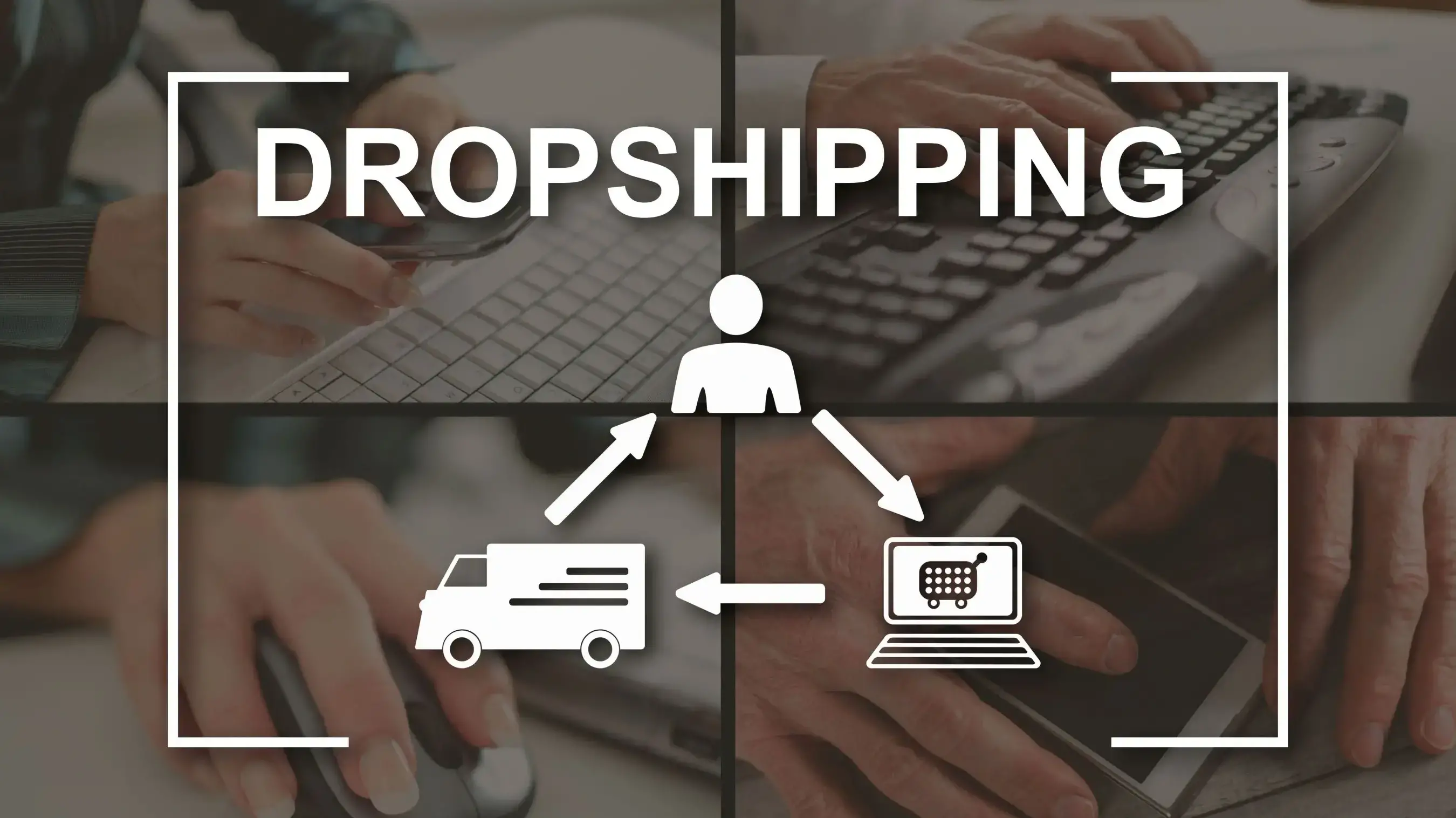E-commerce has changed the way we shop online, opening up new ways for entrepreneurs to start businesses with little upfront cost. About 27% of online stores now use dropshipping as their main way to send orders, and affiliate marketing accounts for about 15% of all money made in digital media.
This guide looks at these two popular methods; affiliate marketing and dropshipping comparing their operational method, risk levels, and potential for profitability, helping you determine which model best suits your goals and capabilities.
What Is Affiliate Marketing?
Affiliate marketing is a digital marketing strategy that allows individuals or companies (affiliates) to earn commissions by promoting other people's or company’s products or services.
It is a mutually beneficial relationship where the affiliate earns a profit through commission-based sales, and the seller gains increased traffic and potential sales without the upfront marketing expense.
How Affiliate Marketing Works
Affiliate marketing involves three key parties: the merchant, the affiliate, and the customer.
1. The Merchant: Also known as the creator, seller, brand, retailer, or vendor. This is the party that creates the product.
2. The Affiliate: Also referred to as the publisher or advertiser, an affiliate can be an individual or a company that markets the seller's products in an appealing way to potential consumers. Affiliates use their platform, be it a blog, social media account, or website to promote products and direct consumers to the merchant’s site.
3. The Customer: The affiliate's marketing activities bring potential customers to the merchant's site through strategic linking. When customers purchase the product, the affiliate receives a commission.
Affiliates share these products or services with their audience using specialised affiliate links. When someone purchases through these links, the affiliate earns a percentage of the sale.
Pros and Cons of Affiliate Marketing
Pros
Cons
Pros of Affiliate Marketing
Low Cost of Entry: Many affiliate programs are free to join, so your startup costs are generally related only to your referral/marketing methods.
No need to create a product or service: You can start selling something as an affiliate as soon as you have a platform to sell it on.
Flexible and Convenient: As an affiliate, you’re essentially a freelancer. You can set your goals, redirect your path as you see fit, choose the products that interest you, and even determine your hours.
Passive income: Once everything is set up, you can make money passively, earning income while you sleep, as people purchase products via your links.
Cons of Affiliate Marketing
High competition: Many affiliate marketers are trying to sell the same products. Standing out from the rest can be challenging.
No control over the competition: Your competitor could be the brand itself or another affiliate.
Commission-based earnings: Your earnings are dependent on a commission structure that you have no control over. If the brand reduces the commission rate, your earnings decrease.
Dependence on the merchant: Changes in the merchant’s website, the closure of a product line, or the company going out of business can negatively impact your earnings.
Step-by-Step Guide to Setting Up Affiliate Marketing

1. Choose the Right Niche: For affiliate marketing success, you need to pick a niche that is both in demand and not overly crowded. Your niche should be something you are passionate about or have expertise in.
2. Select the Right Affiliate Programs: Research and choose affiliate programs that offer good commissions, have a solid reputation, and provide real value to your audience.
3. Build a Website or Blog: Your affiliate promotions need a platform where they can thrive. A blog or a website is the most common place to put your affiliate link. Choose a memorable domain name and reliable hosting to ensure your site is always accessible and fast.
4. Create Quality Content: Regularly produce high-quality content that drives traffic to your site. Use SEO techniques to improve visibility and organically attract visitors.
5. Drive Traffic to Your Affiliate Link: Use different strategies like paid ads, email marketing, and social media to increase traffic to your site.
6. Track and Optimise Your Performance: Use analytics to track your progress and find out what works best. Optimise your strategy accordingly to increase your sales.
Strategies for Effective Affiliate Marketing
Effective affiliate marketing strategies are crucial for maximizing the potential of your campaigns and driving substantial revenue.
Do not rely on a single affiliate program. Diversify your income by promoting multiple products from different vendors.
Develop content that addresses different stages of the customer journey, from awareness to decision-making, ensuring you guide your audience through the buying process effectively.
Leverage tools like Google Analytics to track which affiliate link perform the best and understand where your traffic is coming from.
Optimise your content for search engines to increase visibility. Use targeted keywords, meta descriptions, and high-quality backlinks to improve rankings and attract more traffic to your affiliate links.
Enhance the attractiveness of affiliate products by offering additional bonuses or incentives for purchases made through your links. This could be an exclusive ebook, a webinar, or access to a private group.
Establish a good relationship with your affiliate managers. This can lead to better commission rates, inside information on new products, and custom promotions that can significantly increase your earnings.
Be transparent with your audience about your affiliate relationships. Disclosure not only builds trust but is also required by FTC guidelines in many regions.
What is Dropshipping?

Dropshipping is a streamlined form of retail business wherein the seller accepts customer orders but does not keep goods sold in stock. Instead, in a dropshipping model, the store purchases the item from a third party, usually a wholesaler or manufacturer, and has it shipped directly to the customer.
As a result, the seller does not have to handle the product directly. This model minimises risk and overhead while offering convenience and practicality.
How Does the Dropshipping Business Model Work?
The dropshipping business model involves three key players: the manufacturer, the retailer (you), and the customer. Here’s how it typically operates:
1. The Customer Places an Order: A customer places an order for a product on your online store at a retail price you set.
2. You Forward the Order to Your Supplier: You then forward this order to your dropshipping supplier, either manually or automatically, paying the wholesale price for the product.
3. Your Supplier Ships the Product Directly to the Customer: The supplier packages and ships the order directly to the customer under your business name.
This process eliminates the need for a physical business location, storage space, and large quantities of inventory, making it an attractive option for budding entrepreneurs.
Pros and Cons of Dropshipping
Pros
Cons
Step-by-Step Guide to Setting Up a Dropshipping Store
1. Choose a Niche: Select a niche that is specific, not too broad, and ideally something you are passionate about. This makes marketing efforts more targeted and effective.
2. Research Competitors: Know who your competitors are and what they offer. Understanding your market competition can help you determine how to differentiate your store.
3. Secure a Supplier: Find a reliable supplier who can provide quality products and services. Platforms like AliExpress, SaleHoo, or Oberlo can be good starting points.
4. Create Your E-Commerce Website: Set up your online store using platforms like Shopify or WooCommerce, which simplifies the process. Choose a domain name that reflects your brand and helps you stand out, and select a reliable hosting provider. This is where you will attract customers and process orders.
5. Create a Customer Acquisition Plan: Decide on how you will attract customers to your store. Most dropshippers use a combination of SEO, PPC advertising, email marketing, and social media marketing.
6. Analyse and Optimise: Monitor all areas of your business and regularly test different products and marketing tactics to find out what works best. Always look for ways to improve customer service and your product offerings.
Strategies for Effective Dropshipping
Differentiate your store by developing a strong brand that resonates with your target audience. This includes a memorable logo, a consistent colour scheme, and a unique selling proposition.
Encourage repeat business by offering loyalty programs that reward returning customers with discounts, exclusive offers, or early access to new products.
Implement strategies such as A/B testing different layouts, improving product descriptions with SEO, and enhancing the checkout process to reduce cart abandonment.
Use social media platforms to connect with potential customers, promote products, and run targeted ads. Platforms like Instagram and Facebook are particularly effective for visual products.
Stay competitive by using tools that help adjust your pricing based on market trends and competitor pricing. This can help you attract more customers by offering the best deals.
Affiliate Marketing vs Dropshipping
| Feature | Affiliate Marketing | Dropshipping |
|---|---|---|
| Inventory Management | No need to handle inventory. Affiliates promote products without keeping stock. | Dropshippers don’t stock products but need to manage inventory levels with suppliers. |
| Initial Investment | Minimal; mainly for setting up a website and marketing efforts. | Relatively low but includes expenses for website, supplier setup, and marketing. |
| Control Over Pricing | No control over product prices; earnings based on commission rates. | Full control over pricing, allowing dropshippers to set their profit margins. |
| Customer Interaction | No direct interaction; the merchant handles all customer service and fulfillment. | Direct interaction required; responsible for customer support, returns, and complaints. |
| Profit Margins | Fixed commissions per sale, usually a percentage of the product price. | Variable; depends on the markup over the wholesale price paid to the supplier. |
| Risk Level | Lower risk as there is no need to manage physical products or handle returns. | Higher risk; involves handling customer issues and coordinating with suppliers. |
| Scalability | Scalable with effective marketing and content strategy without additional overhead. | Scalable, but complexities increase with sales volume, including logistics and customer service. |
| Operational Complexity | Relatively simple; focused mainly on content creation and traffic generation. | More complex; includes supplier relations, order management, and fulfillment processes. |
Case Studies
These examples will highlight real-life successes and provide insights into the strategies and challenges faced by individuals in both fields.
Affiliate Marketing Success Stories

1. Pat Flynn’s Smart Passive Income
Pat Flynn started his website, Smart Passive Income, where he shares strategies on how to build an online business and optimize it for passive income. He uses affiliate marketing as one of his primary revenue streams.
Pat’s transparent income reports have shown earnings of over $100,000 per month, largely through affiliate marketing. His strategy focuses on recommending products he uses and believes in, which builds trust with his audience.
Authenticity and trust are critical in affiliate marketing. Pat succeeds by creating in-depth, honest content that genuinely helps his audience, which in turn drives affiliate sales.
2. The Wirecutter (Acquired by The New York Times)
The Wirecutter started as a gear and gadgets reviews site that used thorough testing and research to recommend products. Their income was primarily generated through affiliate links.
The Wirecutter became so successful that it was acquired by The New York Times for about $30 million in 2016.
High-quality, well-researched content that provides real value to consumers can lead to significant affiliate marketing success. Their detailed reviews and easy-to-understand recommendations helped them stand out.
Dropshipping Success Stories

1. Irwin Dominguez from San Diego
An eCommerce newbie, Irwin ventured into dropshipping with no prior experience and managed to generate a million dollars in sales within eight months of launching his online store.
By carefully selecting his niche and products and using Facebook ads effectively to drive traffic and sales, Irwin managed to rapidly scale his business.
Effective marketing and a well-chosen niche are crucial in dropshipping. Learning quickly from advertising data and scaling up successful campaigns can lead to rapid growth and profitability.
2. Ethan Johnson
Ethan began dropshipping as a side project during his last year of university, concentrating on the fitness equipment sector. He identified a gap in the market for affordable yet high-quality home gym gear.
By targeting fitness enthusiasts who prefer to train at home, especially during the recent surge in home workouts, Ethan's business flourished, turning into a seven-figure enterprise within two years.
Choosing a niche that aligns with current trends and consumer behaviors, such as home fitness during the pandemic, allowed Ethan to maximize sales and build a strong, dedicated customer following.
Conclusion
Choosing between affiliate marketing and dropshipping involves understanding your personal goals, skills, and the level of involvement you wish to have in your business. Both business models offer unique opportunities and challenges, providing a profitable avenue for entrepreneurs willing to invest time and effort into building a successful online business.
If you prefer low entry barriers and the potential for passive income, affiliate marketing might be the right choice. This model relies on your ability to effectively market products, engage with your audience, and adapt to changes in the market.
On the other hand, if you have a knack for customer relations and logistics, dropshipping could be more profitable and rewarding as it offers more control over branding and customer interaction.
Understanding these distinctions can help aspiring entrepreneurs make an informed decision on which path to pursue in the competitive world of online retail.
Frequently Asked Questions
What is the difference between affiliate marketing and dropshipping?
Affiliate marketing involves promoting products for other companies and earning a commission on sales, without managing inventory or customer service. Dropshipping allows you to sell products directly from suppliers to customers without stocking inventory, but you manage customer service and set prices.
How can I start an affiliate marketing business?
To start an affiliate marketing business, choose a niche, build an affiliate website, join relevant affiliate networks, and create content that includes affiliate links to earn commissions.
What are some low risk business models for starting an online business?
Both dropshipping and affiliate marketing are considered low risk business models for starting an online business because they require minimal upfront investment and do not involve managing physical inventory.
How do I find dropshipping suppliers for my ecommerce store?
To find dropshipping suppliers, research reputable platforms like AliExpress, SaleHoo, or Oberlo, or contact manufacturers directly to see if they offer dropshipping services. Ensure they provide quality products and reliable shipping.
How do profit margins in dropshipping compare when setting your own prices versus following suggested retail prices?
In dropshipping, setting your own prices usually offers higher profit margins than sticking to suggested retail prices, as you can adjust pricing based on market demand, competitive analysis and your business goals, potentially increasing your profitability.
How can starting an affiliate marketing business model benefit my online business?
Starting an affiliate marketing business model can benefit your online business by providing low-risk entry, as it requires minimal upfront investment and you don't need to manage inventory or fulfill orders, allowing you to focus on marketing and growing your brand.
How can starting an affiliate marketing business through an affiliate program enhance my ability to earn passive income online?
Starting an affiliate marketing business through an affiliate program allows you to earn passive income by promoting products on your own website or online store. This low-risk business model requires minimal upfront investment and frees you from managing inventory or customer service, focusing instead on optimizing marketing costs.

Yetunde Salami is a seasoned technical writer with expertise in the hosting industry. With 8 years of experience in the field, she has a deep understanding of complex technical concepts and the ability to communicate them clearly and concisely to a wide range of audiences. At Verpex Hosting, she is responsible for writing blog posts, knowledgebase articles, and other resources that help customers understand and use the company's products and services. When she is not writing, Yetunde is an avid reader of romance novels and enjoys fine dining.
View all posts by Yetunde Salami





















